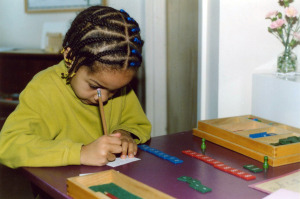
In our education for a new world, we learn to respect and honor the uniqueness of our children, while giving students, teachers and parents the time to learn and forge partnerships. In this new system, children possess a set of age-appropriate tools to organize thoughts and actions, to problem solve, to foster self-expression and to personally manage their lives.
The traditional method of grades won’t suffice. In our new world of education with deep time to explore, research and examine new ideas, only mastery will do. We’ll encourage opportunities to repeat and redo until prowess is accomplished, thereby assuring success for each and every student’s learning.
As we focus on student success while respecting differences, we will realize that one size of schooling does not fit all and never could.
The child who is a hands-on learner will have deep time to master fundamental math ideas as he or she explores, researches and examines concrete math challenges with specially designed materials. We will introduce higher math concepts, such as algebra and geometry, to young children using researched learning materials.
Why give a child an “F” in math if extra time and the right learning challenges and materials bring understanding and mastery?
Research shows that allowing 20 extra minutes per day of hands-on exploration can make a failing college algebra student become an “A” student, and more importantly, an excited and confident learner.
Imagine if we started giving that important 20 minutes of exploration to every student beginning at birth?
The true test of learning is whether you can use acquired knowledge to problem solve. Mastery of fractions? The test may be figuring out the square footage of a house and creating a budget for flooring. Perhaps shopping for materials, getting bids for installation and explaining warranties might be part of this activity that prepares and connects to real life.
Make a mistake on “the test?”
Real-life consequences may appear as not enough material, time or money during the budget process. In adult life, with our “real-life” testing, we keep recalculating until we get it right. If we lack basic understanding, we search out experts to assist us and keep at it until the task is 100% right. Who wants to live in a house that has flooring that is 75% correct and gets a grade of “C?”
In the words of that great Star Wars philosopher Yoda, “Do, or do not. There is no try.”
Our “grading system” should be based on accomplishment of meaningful, life-affirming tasks. Nothing less.
When we respect and honor the individuality of our children in an atmosphere of deep time for relationship building, learning begins to looks very different, as it engages each child in personally meaningful ways that can be expressed in various ways. As our children use their “toolbox” to organize thoughts and actions, to problem solve, to foster self-expression and to personally manage their lives, they become masters of their universe, however large or small that creation may be. There are no A’s or F’s.
There is only do, or do not.
This is a series on creating a fresh approach to education.
Next: Understanding How Learning Takes Place


Really educating piece . Thank you so much for this article. A little extra effort bring out the best in children. Grading system make children competitive and desperate in pursuit of excellence.
Joyce,
Aloha!
Glad you enjoyed the article.
Loved this article about the grading system.
After all..what is the hurry…why can’t we wait till each one reaches a 100% and all get an ‘A’. Beautiful thought.
Maqsooda,
Aloha!
Yes, teaching skills and observing for skills ability.
Can you do something? That is the test.
How can I do it better? That’s the next lesson.
A fun way to learn…and teach.